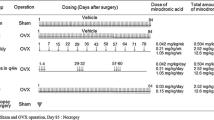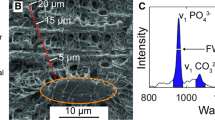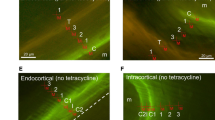Zoledronic acid (ZOL) is a highly potent heterocyclic bisphosphonate which has been shown to inhibit bone resorption in short-term experiments in young growing animals. In this investigation we have evaluated the effects of a 1-year administration to mature, ovariectomized (OVX) rats as a model for postmenopausal osteoporosis in order to elucidate (1) the temporal changes in urinary biochemical markers of bone turnover and femoral bone mineral density (BMD), (2) to measure changes of static and dynamic histomorphometric parameters and mechanical strength, and (3) to assess the preventive effects of chronic treatment with ZOL on these parameters. In urine, deoxypyridinoline increased after OVX and was significantly reduced by ZOL administration, indicative of a reduced bone collagen turnover. These changes were accompanied by alterations of tibial cancellous bone: trabecular bone volume and parameters of bone architecture were significantly augmented by ZOL and bone formation rates fell as a consequence of suppressed bone turnover, but were still measurable. No signs of "frozen bone" or osteomalacia could be detected. BMD of the whole femurs rose in sham-operated control animals (SHAM) during the entire experimental period, whereas in OVX animals, BMD plateaued after 32 weeks at a lower level. ZOL at a low dose (0.3 mg/kg/week s.c.) did not alter whole femur BMD, but at higher doses (1.5 and 7.5 mg/kg/week s.c.) BMD increased to the level of the SHAM group. A distinct pattern was noted for the distal quarter of the femur, a region rich in cancellous bone: BMD initially increased in all treatment groups except the OVX group, and at a later stage fell again at a comparable rate irrespective of treatment. Mechanical stability, as assessed by a 3-point bending test, was significantly increased by all doses of ZOL and exceeded OVX and sham-operated controls. The effects on mechanical properties were observed at a low dose which did not measurably increase femoral BMD after 1-year treatment. Multiregression analysis revealed a significant positive correlation between maximum load and BMD, and a significant negative correlation of maximum load with labeled perimeter, a marker of bone formation and turnover. No significant correlation was found with urinary deoxypyridinoline, a marker of bone resorption. The data show that mechanical testing detects improvements of functional bone quality following low dose bisphosphonate treatment which are not identified by standard DXA measurements of BMD.
Similar content being viewed by others
Author information
Authors and Affiliations
Rights and permissions
About this article
Cite this article
Hornby, S., Evans, G., Hornby, S. et al. Long-Term Zoledronic Acid Treatment Increases Bone Structure and Mechanical Strength of Long Bones of Ovariectomized Adult Rats . Calcif Tissue Int 72, 519–527 (2003). https://doi.org/10.1007/s00223-002-2015-4
Received:
Accepted:
Issue Date:
DOI: https://doi.org/10.1007/s00223-002-2015-4




